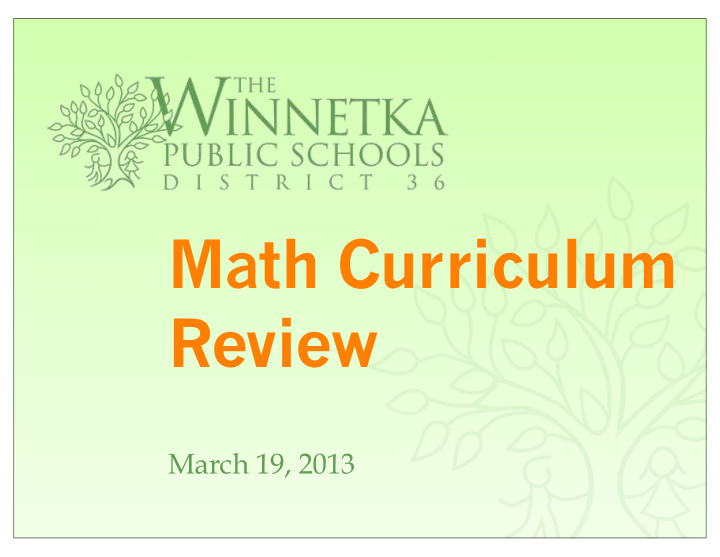



Math Curriculum Review March 19, 2013
Overview of Presentation 1.Overview of Process 2.Mission & Belief Statements 3.Overarching Essential Questions & Enduring Understandings 4.Progression of Curriculum 5.Next Steps
Math Curriculum Committee Eileen Goodspeed, Co-chair Kate Edwards Shannon Anderson, Co-chair Kris Clendenin Peggy Bourke, Co-chair Lindsay Connell Andrea Graf Marla Goldberg Anna Ladik Mary Ellen Schultz April Jordan Mary Lind Beth Niemann Melissa Cook Betsy Steele Michelle Ney Cathy Rosen Mike Dugo Chi Quach Sam Yusim Darcy Aksamitowski Susan Hugebeck Jay Dillon Ted Graf Jean Fink Teri Knaff Judith Campbell Trisha Kocanda Katarina Jaksic
CCSS-M Key Shifts ‣ Focus —depth emphasized to develop greater understanding of mathematics ‣ Coherence —thinking across grades and linking to major topics ‣ Rigor —equal intensity of conceptual understanding, procedural fluency, & application
CCSS-M= Standards for Mathematical Content + Standards for Mathematical Practice
Mission The mission of The Winnetka Public Schools mathematics program is to engage all students in a challenging curriculum of high-quality mathematics. October 2012
Belief Statements We believe that classroom community engages students and supports the development of positive mathematical dispositions. An Engaging Math Environment: • Promotes a mindset of inquiry, risk taking, flexible thinking, and problem solving. • Fosters collaboration, communication, and critique as critical components of understanding. • Encourages multiple approaches, using tools and technology strategically. • Encourages analysis of a variety of solutions as well as misconceptions.
Belief Statements We believe that high quality instruction is the foundation for the development of proficient mathematical learners. High Quality Instruction: • Values students as individual learners. • Provides meaningful tasks. • Emphasizes process and understanding of mathematics to a level of depth appropriate for each learner. • Encourages students to learn from one another. • Provides time to develop perseverance, a level of expertise, and an appreciation of the connectedness of math concepts to the real world. • Endorses multiple methods for students to demonstrate understanding through the use of different modalities (manipulatives; pictures and models; oral and written language; real world situations; written symbols).
Belief Statements We believe that high quality curriculum and assessment allow for acquisition of knowledge, development of meaningful understanding, application and transfer of knowledge. High Quality Curriculum: • Develops skills and concepts in tandem. • Applies concepts to real life contexts and new situations. • Values reflection as part of the learning process. • Is informed by research, state and national standards, and guided by national mathematics organizations.
Belief Statements High Quality Assessment: • Encompasses a wide range of assessment techniques. • Is an ongoing process. • Provides feedback to inform student and teacher, resulting in the growth of all learners. • Addresses procedural skill and fluency, conceptual understanding, and application.
Overarching Essential Questions and Enduring Understandings
Make sense of problems and persevere in solving them. Look for and express regularity Reason abstractly in repeated and quantitatively. reasoning. Construct viable Look for and Standards for arguments and make use of Mathematical critique the structure. Practice reasoning of others. Attend to Model with precision. mathematics. Use appropriate tools strategically.
Content & Practice Standards Content A Cohesive Curriculum Practices
Presentation of KUDs
Math Curriculum: A Progression of Practices
Next Steps Date(s) Description of Activities Desired Products • Pilot teacher feedback submitted for Submit completed pilot tools for April 4 analysis review and analysis Review pilot experiences, alignment to • Select K-5 math resource materials April 11 CCSSM, costs, etc. in order to choose a resource • Document detailing connections and identifying needs for supplemental April 25 Align new resource to curriculum units materials Release and refine scope and sequence • Tightly aligned K-8 scope and sequence of units Present K-5 math resource • Board knowledge of math materials recommendation to School Board and May 7 share revised 6-8 math material and revised 6-8 piloting plan selection plan
Next Steps Date(s) Description of Activities Desired Products Analyze current resources and move to new March– • Crosswalk for transition to new resource to identify possible gaps. Design June crosswalk to transition to new resource to curriculum and resources ensure success for students and teachers. Informing parents of resource selection, April– • WPI, website updates, newsletters, etc. CCSSM implications, and reasoning for October selection This is an on-going process over two years • Developed and implemented cohesive involving different groups of teachers and incorporating differentiated instruction, PD plan to implement new resource with May–June modeling in classrooms, co-teaching, and support for teachers in activating the coaching in order to activate and implement CCSSM Practices the CCSSM and new resource • Minimum of 3 common cornerstone Sept 2013 Develop common cornerstone assessments assessments per grade level to serve as ongoing based on CCSSM and resource formative assessments for PARCC assessment.
Q & A
Recommend
More recommend